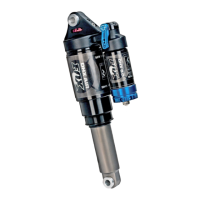Bottom-Out Resistance
Bottom-out resistance affects the final part of the compression stroke. The knob can be turned with a 4 mm hex
key inserted into one of the holes around the perimeter. Do not use any other tool to turn the knob—a 4 mm (or
5/32”) hex key only!
Turn the knob all the way clockwise for the most bottom-out resistance and counter-clockwise for the least.
There are three (3) rotations of adjustment and three (3) corresponding adjustment indicator lines on the
reservoir.
For more bottom-out resistance, turn the knob clockwise.
For less bottom-out resistance, turn the knob counterclockwise.
Note: If the knob feels gritty during rotation, set the knob to maximum volume (fully
counterclockwise), and then use a 2 mm (or 5/64") hex key to loosen the set screws in the
perimeter holes and remove the knob. Clean the knob thoroughly. Lightly grease, then re-install
the knob.
Boost Valve
The Boost Valve creates a position-sensitive damping scheme that allows for a seamless transition from efficient
ProPedal to square-edge bump absorption to a bottomless end-of-stroke feel. The Boost Valve also decouples
the ProPedal and bottom-out adjustments, enabling ProPedal platform adjustments to be made without affecting
the changes made to the bottom-out adjustment.
The Boost Valve is not adjusted directly. Instead, its behavior and performance characteristics are influenced by
the air pressure setting in the reservoir and by adjusting the ProPedal knob.
To change the compression damping characteristics of your DHX Air 5.0 shock, attach a FOX High Pressure
Pump to the air valve on the reservoir:
For a firmer ride, add 10 – 15 pounds of air pressure, to a maximum of 200 PSI.
For a softer ride, decrease the shock’s air pressure 10 – 15 pounds by using the pump’s bleed valve, to
a minimum of 125 PSI.

